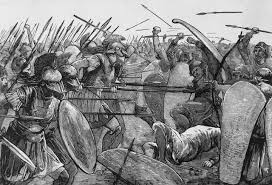
Neville Morley over at The Sphinx Blog:
The Melian Dialogue in Thucydides has been of interest to game theorists since the earliest development of the field; it was discussed on several occasions by John von Neumann, generally accepted founder of this approach, and it appears in the work of a leading game theorist like Thomas Schelling. It’s entirely understandable: the dialogue presents two sides in a high-stakes, zero-sum conflict, pursuing very different strategies with a limited number of possible outcomes, and – if you want to push the boundaries of game theory a bit further, it also offers interesting examples of how each side seeks to anticipate and influence the decision-making of the other, and raises some fundamental questions of rationality. I fully expect to find lots of other examples when I have time to pursue this theme in depth, but for today I want to focus on one case of a game theoretical discussion of the Dialogue, written by the current Greek Finance Minister Yanis Varoufakis (1997; revised version 2014: 262-83). It is in itself an interesting reading of the situation, in relation both to Thucydides and to the normal assumptions of game theory, but there are also some striking implications for the current negotiations between Greece and the EU, especially Germany, which I will consider in the final section.
1. Varoufakis on Thucydides
Varoufakis speaks of Thucydides with familiarity and confidence, and knows him well enough to offer his own translations rather than relying on a standard version. These are generally close to the conventional readings, though with occasional interesting variations. The passages quoted are as follows, in order of their mention:
5.89: On the one hand the principles of justice, encompassed in human reason, hinge on the equal capacity to compel, yet on the other hand, the strong actually do what is possible and the weak suffer what they must.
Varoufakis here echoes (if not follows) Crawley in seeing the weak as ‘suffering’ rather than simply ‘accepting’ what they have to; and is in the tradition of emphasising that the strong ‘do’ what they are able to do rather than, more narrowly, ‘exact’ what they are able to exact. His choice of the phrase ‘encompassed in human reason’ isn’t wholly clear; I feel uncertain whether he wants to emphasise the human element (the idea that, as other translations make clearer, discussions of justice in debased human terms rest on issues of strength and power whereas true, divine justice operates by different rules) or the rational element (which edges into the neo-realist assumption that Thucydides here describes presents lawless anarchy as the true and reasonable state of things, rather than as something to be deplored). Finally, Varoufakis is the only translator I can recall off-hand who seeks to contrast the two parts of the sentence – justice depends on equal power and yet the strong exact and the weak endure – rather than seeing these as consecutive – justice depends on equal power and so the strong exact and the weak endure (i.e. there is no equality and so no justice).
More here.

